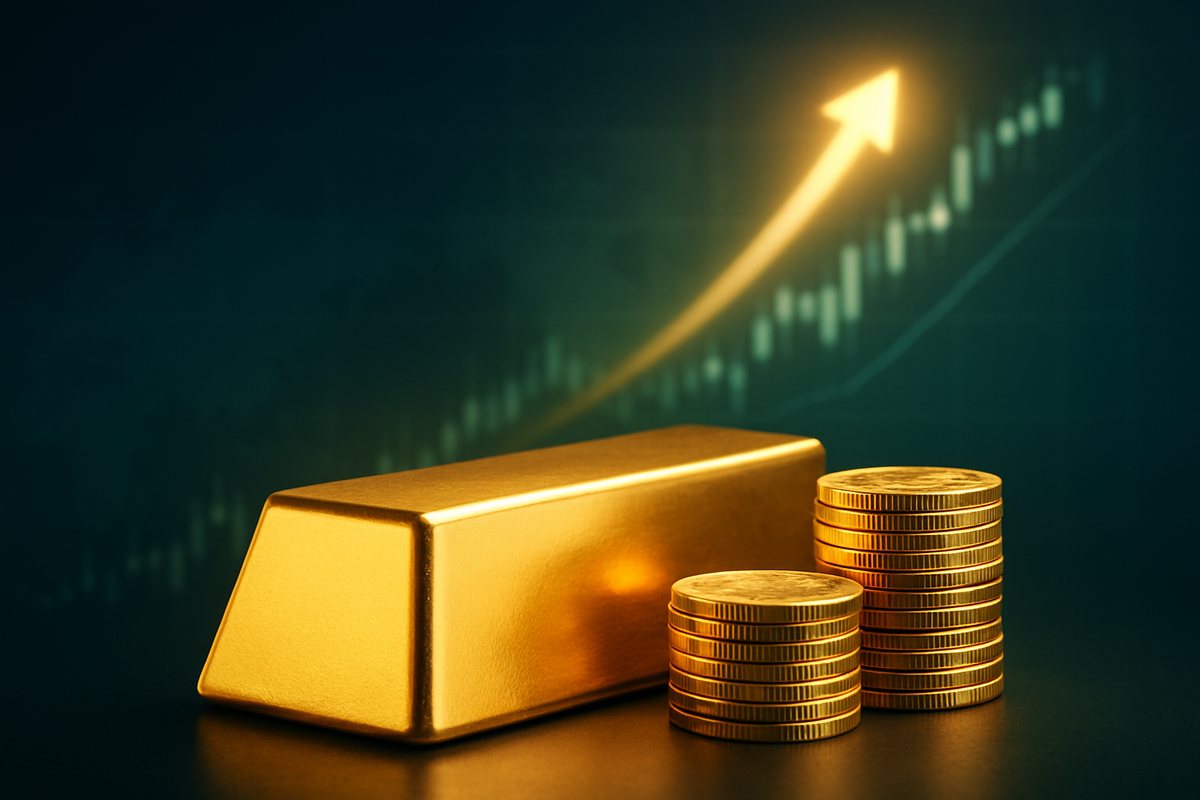
KYOTO, JAPAN – The global financial community is buzzing with a profoundly bullish outlook for gold, as delegates at the London Bullion Market Association's (LBMA) annual gathering in Kyoto on October 28, 2025, have projected the precious metal to reach an astonishing $4,980 per troy ounce within the next 12 months. This bold forecast, representing a significant 27% increase from current levels, underscores a widespread conviction that gold's historic rally is far from over and is set to propel the yellow metal towards the coveted $5,000 mark.
The prediction comes amidst an unprecedented surge in precious metals, with gold already experiencing a remarkable 52% year-to-date increase by October 28, 2025, positioning it for its largest annual rise since 1979. Silver, often seen as gold's more volatile counterpart, has also demonstrated exceptional strength, outperforming gold with a staggering 62% year-to-date gain, reaching its highest annual performance since 2010. This dual-pronged rally signals a significant shift in investor sentiment and global financial dynamics, as a confluence of macroeconomic and geopolitical factors continues to fuel demand for safe-haven assets.
The Golden Ascent: Unpacking the LBMA's Bullish Outlook
The LBMA's forecast of gold hitting $4,980 per ounce by late 2026 is rooted in a comprehensive analysis of prevailing market conditions and anticipated trends. The delegates, representing a broad spectrum of the bullion market, convened at a time when gold has been consistently breaking new ground, defying conventional expectations. The metal's journey to its current elevated status has been swift and dramatic, with gold prices surpassing the critical psychological resistance level of $3,000 per troy ounce in March 2024, then surging past $4,000 per ounce in October 2024. Most recently, it achieved a new all-time record high of $4,381 per ounce on October 20, 2025. As of October 28, 2025, the spot price of gold has been fluctuating around $3,900 to $4,000 per ounce, having recently struggled to maintain the $4,000 level.
The driving forces behind this sustained upward trajectory are multifaceted. Persistent inflation concerns globally, coupled with expectations regarding future US interest rate policies—particularly the anticipation of potential Federal Reserve interest rate cuts—have made gold an attractive hedge against currency devaluation and economic uncertainty. Geopolitical tensions, ranging from ongoing conflicts to broader international instability, further bolster gold's appeal as a safe haven. Moreover, robust and aggressive purchasing by global central banks has been a critical pillar of support. These institutions are increasingly diversifying their reserves away from traditional assets like US Treasuries, signaling a significant structural shift in global asset preferences and a broader trend towards de-dollarization.
The market has also been influenced by a weakening US dollar, which typically makes dollar-denominated gold more affordable for international buyers, thereby boosting demand. Strong investment demand from both institutional and retail investors, fueled by a "fear of missing out" (FOMO) sentiment, has added further momentum. This collective optimism is not confined to gold; silver's impressive performance, reaching a record high of $54.50 per ounce on October 17, 2025, and forecasted to jump to $59 per ounce within a year by LBMA delegates, is largely attributed to strong investment demand, tight supply in the London spot market, elevated purchases (especially in India), and promising industrial demand from sectors like solar panels. The LBMA's collective forecast, therefore, reflects a broad market consensus that the fundamental drivers underpinning this historic rally are expected to persist and potentially accelerate into the coming years.
Corporate Fortunes: Winners and Losers in a $5,000 Gold Market
A sustained gold price at or near $5,000 per ounce would send significant ripple effects across the financial markets, creating clear winners and losers among public companies. Gold mining companies stand to be the most direct beneficiaries. Producers like Barrick Gold (NYSE: GOLD), Newmont Corporation (NYSE: NEM), Agnico Eagle Mines (NYSE: AEM), and Kinross Gold (NYSE: KGC) would see substantial increases in their revenues and profit margins. Higher gold prices directly translate to more valuable reserves and increased profitability per ounce extracted. This could lead to expanded exploration budgets, increased production, and potentially higher dividends for shareholders. Junior mining companies and exploration firms with promising gold deposits could also experience a surge in investor interest and valuations, making it easier for them to secure financing for development.
Conversely, some sectors could face headwinds. Industries heavily reliant on gold as a raw material, such as jewelry manufacturers and certain high-end electronics producers, might see increased input costs, which could squeeze profit margins or necessitate price increases for consumers. While strong consumer demand for gold as an investment might offset some of this, companies like Tiffany & Co. (NYSE: TIF) (now part of LVMH) or other luxury goods brands could face challenges in balancing rising material costs with maintaining competitive pricing. Additionally, investment funds with significant short positions on gold or those that have not adequately diversified into precious metals might experience losses. However, the overall sentiment suggests that the benefits for gold-centric companies would largely outweigh the challenges for others, especially given the current inflationary environment where consumers might be more accepting of higher prices for luxury or investment goods.
Broader Implications: A New Era for Global Reserves and Investment
The LBMA's audacious gold price forecast and the ongoing precious metals rally signal a profound shift in the global financial landscape, extending beyond mere commodity price movements. This event fits squarely into broader industry trends emphasizing de-dollarization and diversification of global reserves by central banks. For the first time in nearly 30 years, gold has dethroned US Treasuries as the primary reserve asset for global central banks, a monumental shift that reflects growing geopolitical uncertainties and a desire among nations to reduce reliance on the US dollar. This trend is likely to continue, with potential ripple effects on sovereign debt markets and international trade dynamics.
Regulatory and policy implications could also emerge. Governments might look to revise mining regulations to encourage domestic production, or even consider strategic gold reserves as a matter of national security. The heightened interest in gold could also spur discussions around the role of digital gold and tokenized precious metals, potentially accelerating the development of new financial instruments. Historically, periods of significant gold appreciation have often coincided with economic instability, high inflation, or major geopolitical events. Comparisons can be drawn to the late 1970s and early 1980s, when gold prices surged amidst high inflation and geopolitical tensions, or the post-2008 financial crisis era. The current rally, however, is unique in its confluence of central bank buying, retail investment fervor, and persistent global uncertainties, suggesting a more structural and long-term re-evaluation of gold's role in the global financial system.
The Road Ahead: Navigating a $5,000 Gold Horizon
Looking ahead, the short-term and long-term possibilities for gold are dominated by continued upward momentum, albeit with potential volatility. In the short term, investors should anticipate continued price discovery as gold approaches and potentially breaches the $5,000 mark. Any significant geopolitical event, further inflationary pressures, or unexpected shifts in central bank monetary policy could act as immediate catalysts for price movements. The sheer volume of central bank purchases is likely to provide a strong floor for prices, mitigating severe downturns.
In the long term, the forecast of $4,980 by 2026 suggests that the fundamental drivers—de-dollarization, inflation hedging, and safe-haven demand—are expected to persist. This could necessitate strategic pivots for various market participants. Investment firms may need to increase their allocation to precious metals, while central banks might further accelerate their gold accumulation programs. Market opportunities will emerge in gold-backed ETFs, gold mining equities, and potentially in innovative financial products tied to gold. Challenges might include increased market speculation, potential for price bubbles if the rally becomes detached from fundamentals, and the need for robust risk management strategies. Potential scenarios range from a steady ascent to $5,000 and beyond, driven by sustained demand, to periods of consolidation as the market digests new price levels before resuming its upward trajectory.
A Golden Future: Key Takeaways and Investor Watchpoints
The LBMA's forecast for gold to reach $4,980 per ounce by 2026 serves as a powerful testament to the enduring appeal and growing importance of precious metals in the contemporary financial landscape. The key takeaway is that the factors driving gold's historic rally—central bank diversification, geopolitical instability, inflation concerns, and robust investment demand—are deeply entrenched and are projected to sustain this momentum into the foreseeable future. Gold's recent dethroning of US Treasuries as the primary reserve asset for global central banks marks a pivotal moment, signaling a structural shift in how nations perceive and manage their wealth.
Moving forward, the market is poised for continued strength in precious metals. Investors should closely monitor central bank purchasing patterns, global inflation data, and any shifts in major economic policies, particularly from the US Federal Reserve. Geopolitical developments will also remain a critical watchpoint, as they often trigger flights to safety. While the outlook is overwhelmingly bullish, prudent investors will also consider the potential for short-term corrections and ensure diversified portfolios. The journey towards a $5,000 gold price is not just a speculative prediction; it reflects a deep-seated transformation in global finance, where gold is reclaiming its ancient role as a bedrock of stability and value.
This content is intended for informational purposes only and is not financial advice






